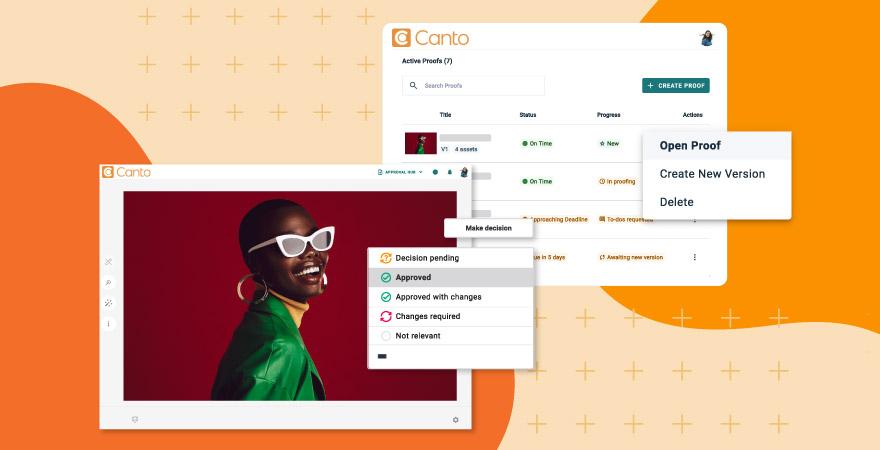Digital asset management trends marketing leaders can’t ignore
| September 12, 2025

Key takeaways:
- DAM adoption is surging, with double-digit global DAM market growth
- AI-driven content organization and discovery save time and amplify ROI
- Centralized ecosystems and workflow automation eliminate silos and speed up production
- DAM ensures omnichannel brand consistency across every market touchpoint
- Leaders who act now gain governance, agility, and measurable returns
The market for digital asset management is no longer niche — it’s a fast-scaling industry. Grand View Research values the global DAM market at $4.22 billion in 2023, projecting a 16.2% CAGR through 2030. Fortune Business Insights projects growth from $4.59 billion in 2024 to $16.18 billion in 2032, a 17% CAGR.
This explosive expansion confirms one thing: DAM market trends point to digital asset management systems’ evolution from a “nice-to-have” into a cornerstone of modern marketing operations.
For marketing leadership, DAM software isn’t simply about file management anymore. It’s about driving efficiency, scaling campaigns globally, and maintaining brand control in a complex, omnichannel environment.

Detailed below are the six DAM trends you need to know about to supercharge growth.
1. Centralized and intelligent content ecosystems are eliminating silos
Fast-moving organizations can’t afford scattered storage. A centralized DAM brings every team — creative, sales, product, regional marketing — into one ecosystem. By creating a centralized digital asset library that connects to your existing marketing stack, leaders remove silos, empower distributed workforces, and enforce governance at scale.
In contrast, cloud file storage tools create risk, duplication, and inconsistency. That’s why many companies are ditching cloud storage for DAM in favor of purpose-built platforms for enterprise marketing and brand management.
What’s trending: Marketing teams need intuitive tools with no learning curve to remain agile and focused on launching campaigns, like Canto DAM.
2. Improved content organization, discovery, and usage are accelerating ROI.
Marketing teams generate more content than ever — videos, ads, sales decks, campaign imagery, and more. Without AI, searching and sorting is costly chaos. Today’s DAM systems use AI-powered search, smart tags, facial recognition, and refined metadata filtering to instantly tag, sort, and surface the right assets.
For leadership, this means faster campaign cycles, more asset reuse, clear ROI through reduced waste, and quicker speed-to-market.
What’s trending: DAM vendors are all touting AI-powered search. Canto AI Visual Search offers the most intuitive and accurate DAM search experience marketers have ever seen.
3. Automated workflows and production are boosting content velocity
Marketing efficiency is under pressure. DAM directly addresses content production bottlenecks with automated DAM workflows — from creative requests to approvals to distribution. Features like workflow automation, streamlined approval workflow processes, and built-in version control keep projects moving without costly delays.
What’s trending: Marketers need scalable content production solutions to meet demanding launch schedules. Canto Approval Hub brings all creative proofing and approval into one place, speeding up content velocity and aligning stakeholders in real time.
4. Centralized brand management is improving omnichannel brand consistency
Organizations need to maintain brand consistency across dozens of markets and channels. DAM centralizes brand governance, bringing together your brand identity, digital assets, and teams into one space. With DAM software, you can finally enforce brand standards, lock down brand elements, and automate compliant content usage.
With a DAM platform, campaigns, product launches, and expansions land with the right voice and brand identity — an outcome leadership can’t achieve with cloud storage.
What’s trending: Organizations must collaborate quickly with third parties for co-branding, partnership, and influencer campaigns — all while retaining compliance. With unlimited Canto Portals, your organization can scale brand content collaboration effectively.
6. Automated publishing is maximizing reach
Modern DAM software enables on-brand asset delivery automation across channels. Platforms can automatically publish assets to websites, storefronts, and social media, eliminating manual distribution and version control workflows for marketing, web, and e-commerce teams.
For leadership, this automation ensures that every customer touchpoint reflects the latest brand-approved content while maximizing marketing efforts across teams.
What’s trending: Marketers must regularly deliver unique omnichannel content. By automating delivery workflows with tools like Canto Media Publisher, marketers can focus on more strategic projects while on-brand media deploys to sites, stores, and platforms automatically.
Preparing for the future of DAM
Recent reports point to DAM evolving into a true content supply chain platform. Expect deeper AI integration for predictive tagging and asset recommendations, and hybrid-cloud models that balance security with scalability.
These DAM trends underscore a clear reality for marketing leaders: DAM can no longer be considered a storage solution, but is now widely accepted as a strategic growth engine. Ignoring these market shifts risks falling behind competitors already using DAM to move faster, govern better, and deliver more consistent brand experiences.

